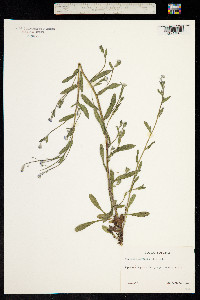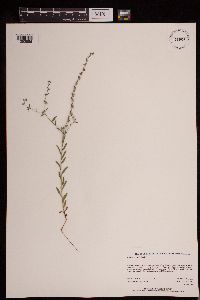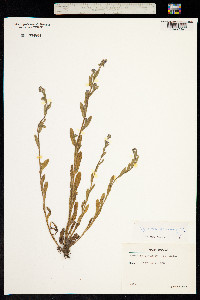Myosotis arvensis
|
|
|
|
Family: Boraginaceae
Rough Forget-Me-Not
|
Annual or biennial herb 10 - 40 cm tall Stem: erect or ascending, often branching above, normally covered with appressed, somewhat stiff, tangled hairs. Leaves: alternate, stalkless, hairy, 1 - 6 cm long, 0.3 - 1.6 cm wide, inversely lance-shaped below, but upwards more oblong or lance-shaped though widest past middle, tapering toward base, and sometimes with somewhat pointed tips. Inflorescence: terminal, up to half the length of entire plant, one-sided, bractless, appressed-hairy, spike-like branches with coiled tips, and many stalked flowers. Flowers: stalked, usually blue with yellow centers (occasionally white), small (2 - 4 mm broad), radially symmetric, somewhat funnel-shaped with well-developed tube and shorter, spreading or upward curved, rounded lobes. The ascending or spreading flower stalks are usually longer than the sepals (3 - 5 mm), and elongate up to 1 cm in fruit. Sepals: five, but fused at base, then separating into five, lance-shaped lobes which are usually longer than the fused base. The calyx as a whole is 3 - 5 mm long, and rough with stiff hooked hairs, non-hooked stiff hairs, and sometimes also glandular hairs. Petals: five, but fused for over half their length into a relatively narrow tube, then separating into five, rounded, spreading but ascending lobes, which form a cup-like shape. At the base of the petal lobes, the throat of the petal tube is blocked by five small projections or appendages (fornices). Stamens: five, attached to inside of petal tube by short filaments, the anthers not extending past the petal tube. Pistil: with one, deeply four-lobed, superior ovary; one, short (shorter than nutlets), inconspicuous style; and one, unlobed stigma. Fruit: a cluster of four, fairly erect, shiny, greenish black to black, smooth, up to 2.5 mm long, under 1.5 mm wide, compressed or somewhat flattened lengthwise, somewhat egg-shaped nutlets with pointed tips and a prominent lateral ridge running around the edge of the flattened faces. The nutlet clusters are enclosed by the fairly erect sepal lobes, and held on ascending or spreading, up to 1 cm long stalks. Similar species: Myosotis arvensis is often confused with M. sylvatica, but that species has broader flowers (0.5 - 1 cm) with more flat-spreading petal lobes, and the sepals are spreading in fruit. Other species of Myosotis in the Chicago Region either have flower stalks shorter than the sepals, or they lack any hooked hairs in the inflorescence. Flowering: June to August Habitat and ecology: Native to Eurasia, a rare introduction or escape in the Chicago Region. Occurence in the Chicago region: non-native Author: The Field Museum Biennial or sometimes annual, 1-4 dm, often branched above, strigose to hirsute-puberulent throughout; lvs 1-6 cm נ3-16 mm, the lower mostly oblanceolate, the upper often more oblong or lanceolate; infl slightly if at all longer than the leafy part of the plant; mature pedicels ascending or spreading, equaling or generally surpassing the 3-5 mm cal; cal hirsute-puberulent and shortly uncinate-hispid; cor blue or occasionally white, the limb 2-4 mm wide; nutlets distinctly surpassing the style; 2n=50-54. Native of Eurasia, established in fields and roadsides from Nf. to Minn., s. sometimes to N.H. and W.Va. Summer. Gleason, Henry A. & Cronquist, Arthur J. 1991. Manual of vascular plants of northeastern United States and adjacent Canada. lxxv + 910 pp. ©The New York Botanical Garden. All rights reserved. Used by permission. From Flora of Indiana (1940) by Charles C. Deam ...... Indiana Coefficient of Conservatism: C = null, non-native Wetland Indicator Status: FAC |





















































































